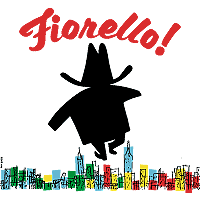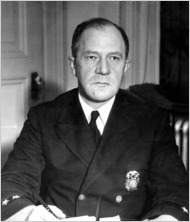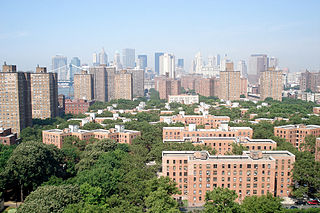
Fiorello Henry La Guardia was an American attorney and politician who represented New York in the House of Representatives and served as the 99th Mayor of New York City from 1934 to 1946. He was known for his irascible, energetic, and charismatic personality and diminutive, rotund stature. An ideologically socialist member of the Republican Party, La Guardia was frequently cross-endorsed by parties other than his own, especially parties on the left under New York's electoral fusion laws. A panel of 69 scholars in 1993 ranked him as the best big-city mayor in American history.

Fiorello H. LaGuardia High School of Music & Art and Performing Arts, often referred to simply as LaGuardia or "LaG", is a public high school specializing in teaching visual arts and performing arts, located near Lincoln Center in the Lincoln Square neighborhood of the Upper West Side in Manhattan, New York City. Located at 100 Amsterdam Avenue between West 64th and 65th Streets, the school is operated by the New York City Department of Education, and resulted from the merger of the High School of Music & Art and the School of Performing Arts. The school has a dual mission of arts and academics, preparing students for a career in the arts or conservatory study as well as a pursuit of higher education.

Fiorello! is a musical about New York City mayor Fiorello La Guardia, a reform Republican, which debuted on Broadway in 1959, and tells the story of how La Guardia took on the Tammany Hall political machine. The book is by Jerome Weidman and George Abbott, drawn substantially from the 1955 volume Life with Fiorello by Ernest Cuneo, with lyrics by Sheldon Harnick, and music by Jerry Bock. It won the three major theatre awards - Tony Award, the New York Drama Critics Circle award, and the Pulitzer Prize for Drama. It is one of only ten musicals to win the latter award.

The High School of Performing Arts was a public alternative high school established in 1947 and located at 120 West 46th Street in the borough of Manhattan, New York City, from 1948 to 1984.
Patrick J. Walsh was appointed Acting Fire Commissioner of the City of New York by Mayor Fiorello H. La Guardia on May 8, 1941, and was subsequently appointed the 14th Fire Commissioner of the City of New York by Mayor LaGuardia two days later. He served in that position until the end of the LaGuardia Administration on December 31, 1945. He died on September 22, 1946, at the West Hill Sanitarium.
La Guardia or variants may refer to:

West Broadway is a north-south street in the New York City borough of Manhattan, separated into two parts by Tribeca Park. The northern part begins at Tribeca Park, near the intersection of Avenue of the Americas, Walker Street and Beach Street in Tribeca. It runs northbound as a one-way street past Canal Street and becomes two-way at the intersection with Grand Street one block farther north. West Broadway then operates as a main north-south thoroughfare through SoHo until its northern end at Houston Street, on the border between SoHo and Greenwich Village. North of Houston Street, it is designated as LaGuardia Place, which continues until Washington Square South.

Lewis Joseph Valentine was the New York City Police Commissioner from 1934 to 1945, under Mayor Fiorello H. LaGuardia during the Murder, Inc. era. He was the author of an autobiography Night stick: The autobiography of Lewis J. Valentine. He was Police Commissioner of New York for eleven years, longer than any other previous person in that position. Time magazine credited him with cleaning up the department so that New York City had one of the most honest police departments in the nation.

Mayor Fiorello H. LaGuardia Houses, also known as LaGuardia Houses, is a public housing development built and maintained by the New York City Housing Authority (NYCHA) on the Lower East Side of Manhattan. Mayor Fiorello H. LaGuardia Houses is composed of thirteen buildings, all of which are sixteen stories tall. The buildings have 1,093 apartments and house approximately 2,596 people. The complex occupies 10.96 acres (4.44 ha), and is bordered by Madison Street to the north, Montgomery Street to the east, Cherry Street to the south, and Rutgers Street to the west. LaGuardia Houses Addition is a sixteen-story tower for elderly people at the corner of Jefferson Street and Cherry Street.

Arthur William Wallander, Sr. was New York City Police Commissioner from 1945 to 1949. He was the only Police Commissioner to be retained by an incoming Mayor of New York City.

Sullivan Street is a street in Lower Manhattan, which previously ran north from Duarte Square at Canal Street, but since around 2012 begins at Broome Street, to Washington Square South, through the neighborhoods of Hudson Square, SoHo, the South Village and Greenwich Village. It runs parallel to and between Macdougal Street and Thompson Street. Part of the street is in the MacDougal–Sullivan Gardens Historic District. The street was named for Revolutionary War Major General John Sullivan in 1799; before then, it was known as Locust Street.

Frances Hodgson Burnett Memorial Fountain, located near Fifth Avenue and the Museum of the City of New York in Manhattan's Central Park, is an outdoor bronze sculpture and fountain which serves as a memorial to Burnett, the author of several literary classics including The Secret Garden and Little Lord Fauntleroy.

Gemma La Guardia Gluck was an American writer, of Italian Jewish origin, who lived in Hungary and was a survivor of the Holocaust. Her autobiography, published in 1961, tells of her experience as a survivor of the Ravensbrück concentration camp, but also offers vivid memories of her childhood spent in America with her parents and brother Fiorello La Guardia, the future first Italian-American mayor of New York.

An election was held on November 7, 1939 for the members of the New York City Council. Although the results of the election were not in by the next day, The Brooklyn Citizen was willing to predict that all the candidates endorsed by Judge Samuel Seabury and Mayor Fiorello H. La Guardia were defeated as they had been in the other municipal contests that day, due in large part to the domestic popularity of President Franklin D. Roosevelt. The reduced turnout compared to 1937 threatened to wipe out at least 9 of the Council's then-26 seats, given that 75,000 votes were required for each seat.

Elections were held for New York City's five borough presidencies on November 7, 1933, the same day as aldermanic elections, the aldermanic presidential election, and the mayoral election. Republicans or Fusionists won Queens, Brooklyn, and Richmond, while Democrats retained office in Manhattan and The Bronx. This gave mayor-elect Fiorello H. La Guardia control of the Board of Estimate and Apportionment.

The 1929 New York City mayoral election was held on November 5 in concert with other municipal elections. Democratic incumbent Jimmy Walker defeated Republican challenger Fiorello H. La Guardia in what was considered "a Crushing Defeat to [the] City G.O.P. [delivered]" by Tammany Hall. Socialist candidate Norman Thomas also ran, as did Socialist Labor candidate Olive M. Johnson and former Police Commissioner Richard Edward Enright for the Square Deal Party.

The New York City mayoral election of 1941 took place on November 4, 1941, in New York City. The candidates were incumbent Mayor Fiorello La Guardia, a Republican, and King County District Attorney William O'Dwyer, a Democrat, as well as other, third-party candidates. La Guardia was also the nominee of the American Labor Party, and additionally ran on the City Fusion and City ballot lines.

The 1937 New York City mayoral election took place on November 2, 1937 in New York City. Incumbent Mayor Fiorello La Guardia, the Republican candidate, was reelected with 60.09% of the vote, defeating the Democratic candidate Jeremiah T. Mahoney, a lawyer and former New York Supreme Court justice, as well as other, third party candidates. La Guardia was also the nominee of the American Labor Party, and additionally ran on the City Fusion and Independent Progressive ballot lines, while Mahoney ran on the Trade Union and Anti-Communist party lines.

The New York City mayoral election of 1933 took place on November 7, 1933, in New York City. Incumbent Democratic Mayor John P. O'Brien, who was elected in a special election after the resignation of Mayor Jimmy Walker, faced Republican Congressman and 1929 mayoral candidate Fiorello La Guardia, and former acting mayor and President of the New York City Board of Aldermen Joseph V. McKee, who became acting mayor after Walker's resignation until the special election, and ran on the Recovery Party line.

The 1921 New York City mayoral election took place on November 8, 1921, resulting in a victory for Democratic Party candidate John Francis Hylan.

















